Experimental Study on the Synergistic Solidification of Soft Soil with Ceramic Powder–Slag–Phosphorus Slag
Abstract
:1. Introduction
2. Test
2.1. Test Raw Materials
2.1.1. Soft Soil Sample
2.1.2. Curing Agent
2.2. Test Proportioning Design
2.3. Test Methods
2.3.1. Sample Preparation and Maintenance
2.3.2. Unconfined Compression Strength Test
2.3.3. Microscopic Experiment
3. Test Results and Analysis
3.1. Orthogonal Test Result
3.2. The Effect of Initial Water Content on the Mechanical Properties of Solidified Soil
3.3. The Effect of Solidifying Agent Content on Mechanical Properties of Solidified Soil
3.4. The Effect of Solidifying Agent Content on the Strength of Solidified Soil
3.5. CSP Solidification Mechanism of the Multi-Component Composite System
3.5.1. X-ray Diffraction Test
3.5.2. SEM-EDS Test
- Micromorphology analysis
- 2.
- EDS spectrum analysis
4. Microscopic Strengthening Mechanism of Soft Soil Reinforced by CSP
- Volcanic ash reaction: The addition of alkaline agents provides a good alkaline environment for exciting potential active tissues in soft soil and curing agents. Ceramic powder contains a large amount of active SiO2 and Al2O3, and three-dimensional network structures such as silica and aluminum oxide dissolve in an alkaline environment, generating [Al(OH)4]− and [SiO(OH)3]− plasma monomers. Subsequently, ionic monomers are attracted and connected via hydroxyl groups to form intermediate complexes. Then, they are dehydrated and condensed to form an oligomeric aluminosilicate vitreous sol. Under the excitation of an alkaline agent, the slag and phosphorous slag release a large amount of Ca2+ and further react with aluminosilicate vitreous sol to generate a gel such as calcium silicate hydrate (C-S-H) and calcium aluminosilicate hydrate (C-A-S-H). At the same time, the surplus Ca2+ will combine with OH− to generate Ca(OH)2 tabular crystals, which will absorb CO2 in the air in an alkaline environment to carbonize and generate CaCO3 whiskers. The Si-O-Si and other glass bodies in the soft soil structure also dissolve in the alkali environment, forming silicate series gel with the help of the curing agent. The soil system becomes more compact under the action of the generated series of polymers, hardening the rigidity of the solidified soil and strengthening the stability of the solidified soil.
- Micro aggregate effect: The incompletely reacted ceramic powder, slag, and phosphorus slag particles further refine the soil pore structure via the micro aggregate effect. The good intercalation between coarse particles increases the internal friction force of the soil, improves the compactness of the pore structure and interface structure, and provides a good spatial environment for various hydration reactions.
- Ion exchange reaction: Under the action of OH−, many low valent cations such as K+ and Na+ adsorbed on the surface of soft soil capture the high valent cations such as Ca2+ released from the hydration of slag and phosphorus slag for ion exchange. With the addition of these high valent cations, the double layer structure of particles is reduced, the electrokinetic potential is lowered, and the bound water is released, reducing the thickness of the bound water film on the surface of particles, leading to the flocculation and agglomeration of soil particles. The greater the binding force between each other, the greater the cohesion between soil particles, and the more significant the strength improvement of solidified soil.
5. Conclusions and Recommendations
- Through the orthogonal test, the main factors influencing the unconfined compressive strength were found in the following descending order: water glass modulus > water glass content > inorganic binder ratio. The ratio of ceramic powder/slag/phosphorus slag was 3:2:1, the water glass modulus was 1, and the water glass content was 26%. With these parameters, the unconfined compressive strength was 2.382 MPa.
- As the moisture content increases from 30% to 45%, the 28-day strength decreases by 66.56%. As the curing agent increased from 14% to 20%, the 28-day strength increased by 40.85%. The additive triisopropanolamine has the best effect on promoting. When the content of triisopropanolamine was 2.0% and 1.5%, the compressive strength of the 7-day and 28-day solidified soil specimens increased the most significantly by 31.7% and 32.8%, respectively.
- Through the analysis of the microscopic test results, it was found that, under the action of the alkaline agent, the constantly generated hydration products tightly bonded with the soil particles to form a dense gel crystal network structure, the soil structure was more compact, and the mechanical properties of the solidified soil were significantly improved.
Author Contributions
Funding
Institutional Review Board Statement
Informed Consent Statement
Data Availability Statement
Conflicts of Interest
References
- Zhu, Y. Research on the Mechanical Mechanism of Polymer Mixing Pile Strengthening Soft Soil Foundation. Master’s Thesis, Chang’an University, Xi’an, China, 2020. [Google Scholar]
- Liu, J.; Luo, H.; Lei, H.; Zhen, G.; Cheng, X. Research progress on alkali activated geological polymer solidification of soft soil. Silic. Bull. 2023, 42, 565–574. [Google Scholar] [CrossRef]
- Wang, A.; Huang, Z.; Zhan, Q.; Zhang, Y.; Dong, W. Mechanical properties and mechanism analysis of recycled aggregate industrial waste synergistic solidification of soft soil. Mater. Introd. 2022, 36, 230–234. [Google Scholar]
- Basha, E.A.; Hashim, R.; Mahmud, H.B.; Muntohar, A.S. Stabilization of residual soil with rice husk ash and cement. Constr. Build. Mater. 2005, 19, 448–453. [Google Scholar] [CrossRef]
- Khattak, M.J.; Alrashidi, M. Durability and mechanistic characteristics of fiber reinforced soil–cement mixtures. Int. J. Pavement Eng. 2006, 7, 53–62. [Google Scholar] [CrossRef]
- Sudhakaran, P.; Sharma, K.; Kolathayar, S. Soil Stabilization Using Bottom Ash and Areca Fiber: Experimental Investigations and Reliability Analysis. J. Mater. Civ. Eng. 2018, 30, 04018169. [Google Scholar] [CrossRef]
- Degirmenci, N.; Okucu, A.; Turabi, A. Application of phosphogypsum in soil stabilization. Build. Environ. 2007, 42, 3393–3398. [Google Scholar] [CrossRef]
- Al-Mukhtar, M.; Khattab, S.; Alcover, J. Microstructure and geotechnical properties of lime-treated expansive clayey soil. Eng. Geol. 2012, 139, 17–27. [Google Scholar] [CrossRef]
- Liang, S.; Zhou, S.; Dai, J.; Wang, M. Experimental study on the solidification of Guangzhou Nansha soft soil with slag and cement. Ind. Archit. 2015, 45, 116–120. [Google Scholar]
- Wu, D.; Chen, K.; Zhang, Z.; Chang, L. Influence of Some Additives on the Properties of OPC Solidified Sandy Silt. Appl. Sci. 2021, 11, 7252. [Google Scholar] [CrossRef]
- Dhar, S.; Hussain, M. The strength behaviour of lime-stabilised plastic fibre-reinforced clayey soil. Road Mater. Pavement Des. 2019, 20, 1757–1778. [Google Scholar] [CrossRef]
- Huang, X. Optimization of Solidification Formula and Study on Mechanical Properties of Hefei Binhu Muddy Soil. Master’s Thesis, Anhui Jianzhu University, Hefei, China, 2021. [Google Scholar]
- Xia, L. Indoor Experimental Study on Solidified Soft Soil Using Fly Ash Slag Based Polymer. Master’s Thesis, Zhejiang University of Technology, Hangzhou, China, 2021. [Google Scholar]
- Dai, X. Macro-Mechanical Analysis of Phosphorus Slag Fiber Reinforced Concrete. Master’s Thesis, Guizhou University, Guiyang, China, 2022. [Google Scholar]
- Yong, L.; Kim Hung, M.; Koting, S. Phosphorus slag in supplementary cementitious and alkali activated materials: A review on activation methods. Constr. Build. Mater. 2022, 352, 129028. [Google Scholar] [CrossRef]
- Liu, Y. Preparation of Phosphorus Slag Fly Ash Geopolymer and Study on Its Solidification of Pb, Cr, U (VI). Master’s Thesis, South China University, Hengyang, China, 2021. [Google Scholar]
- Haoxin, L.; Xiang, Y.; Chao, X. Effect of C–S–H seed/PCE nanocomposites and triisopropanolamine on portland cement properties: Hydration kinetic and strength. J. Build. Eng. 2022, 57, 104946. [Google Scholar]
- Zhang, T.; Sun, Z.; Yang, H.; Ji, Y.; Yan, Z. Enhancement of triisopropanolamine on the compressive strength development of cement paste incorporated with high content of wasted clay brick powder and its working mechanism. Constr. Build. Mater. 2021, 302, 124052. [Google Scholar] [CrossRef]
- Yi, Y.; Li, C.; Sun, C.; Zhang, Z.; Liu, S. Experimental study on alkali activated mineral powder solidification of soft soil in Lianyungang. J. Rock Mech. Eng. 2013, 32, 1820–1826. [Google Scholar]
- Zhu, K. Experimental Study on Solidification and Road Performance of Muddy Soil. Master’s Thesis, Zhejiang University, Hangzhou, China, 2021. [Google Scholar]
- Shi, X. Study on the Mechanical Properties of High Moisture Content Dredged Sludge Solidified Soil Based on Alkaline Slag. Master’s Thesis, Hubei University of Technology, Wuhan, China, 2020. [Google Scholar]
- Fang, Z.; Wen, B.; Liu, R. Research progress on ceramic powder as mineral admixture for concrete. Concr. Cem. Prod. 2019, 8, 22–26. [Google Scholar]
- Jia, Z.; Wen, B.; Zhang, H.; Zhang, J. Study on the effect of ceramic tile polishing powder on the properties of cement mortar. Concrete 2021, 6, 117–120. [Google Scholar]
- Li, L.G.; Zhuo, Z.Y.; Zhu, J.; Chen, J.J.; Kwan, A.K.H. Reutilizing ceramic polishing waste as powder filler in mortar to reduce cement content by 33% and increase strength by 85%. Powder Technol. 2019, 355, 119–126. [Google Scholar] [CrossRef]
- Li, M.; Wang, Q.; Yang, J.; Guo, X.; Zhou, W. Strength and Mechanism of Carbonated Solidified Clay with Steel Slag Curing Agent. KSCE J. Civ. Eng. 2020, 25, 805–821. [Google Scholar] [CrossRef]
- Wang, D.; Xiao, J.; He, F.; Zhou, Y. Durability evolution and associated micro-mechanisms of carbonated reactive MgO-fly ash solidified sludge from East Lake, China. Constr. Build. Mater. 2019, 208, 1–12. [Google Scholar] [CrossRef]
- GB/T50123-2019; Standard for Geotechnical Testing Method. China Planning Press: Beijing, China, 2019.
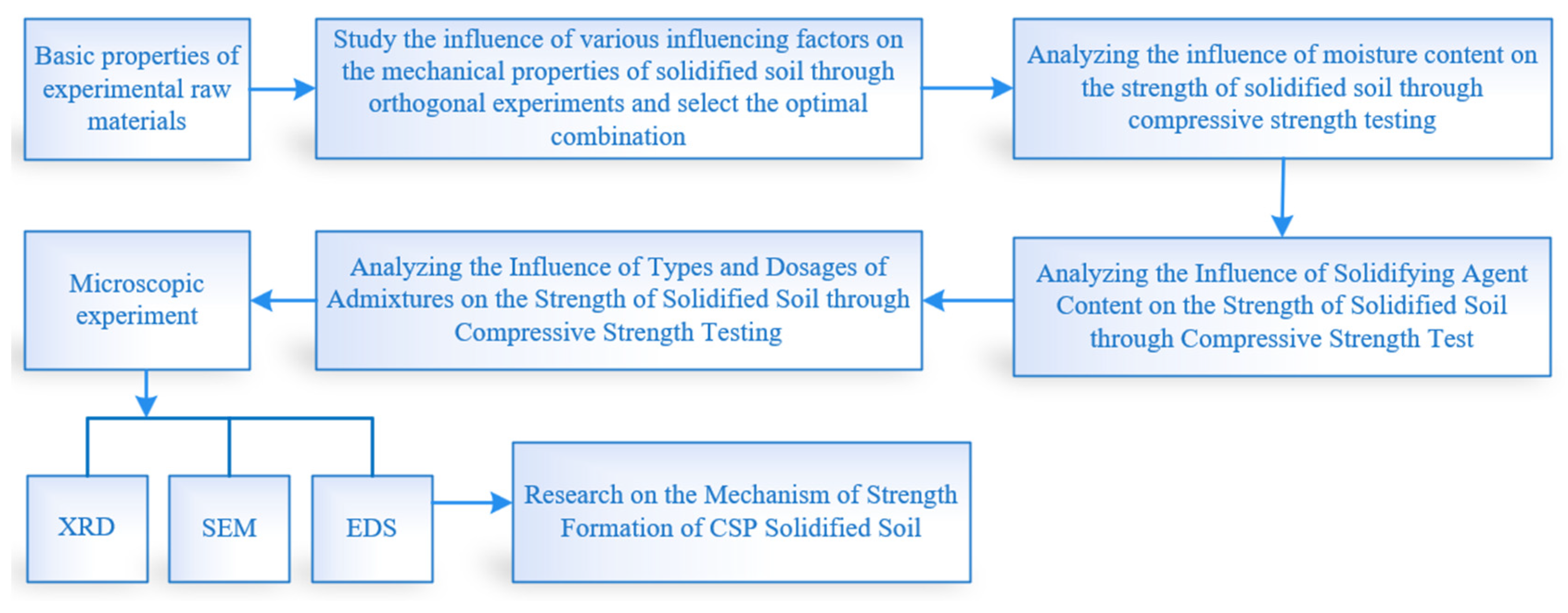
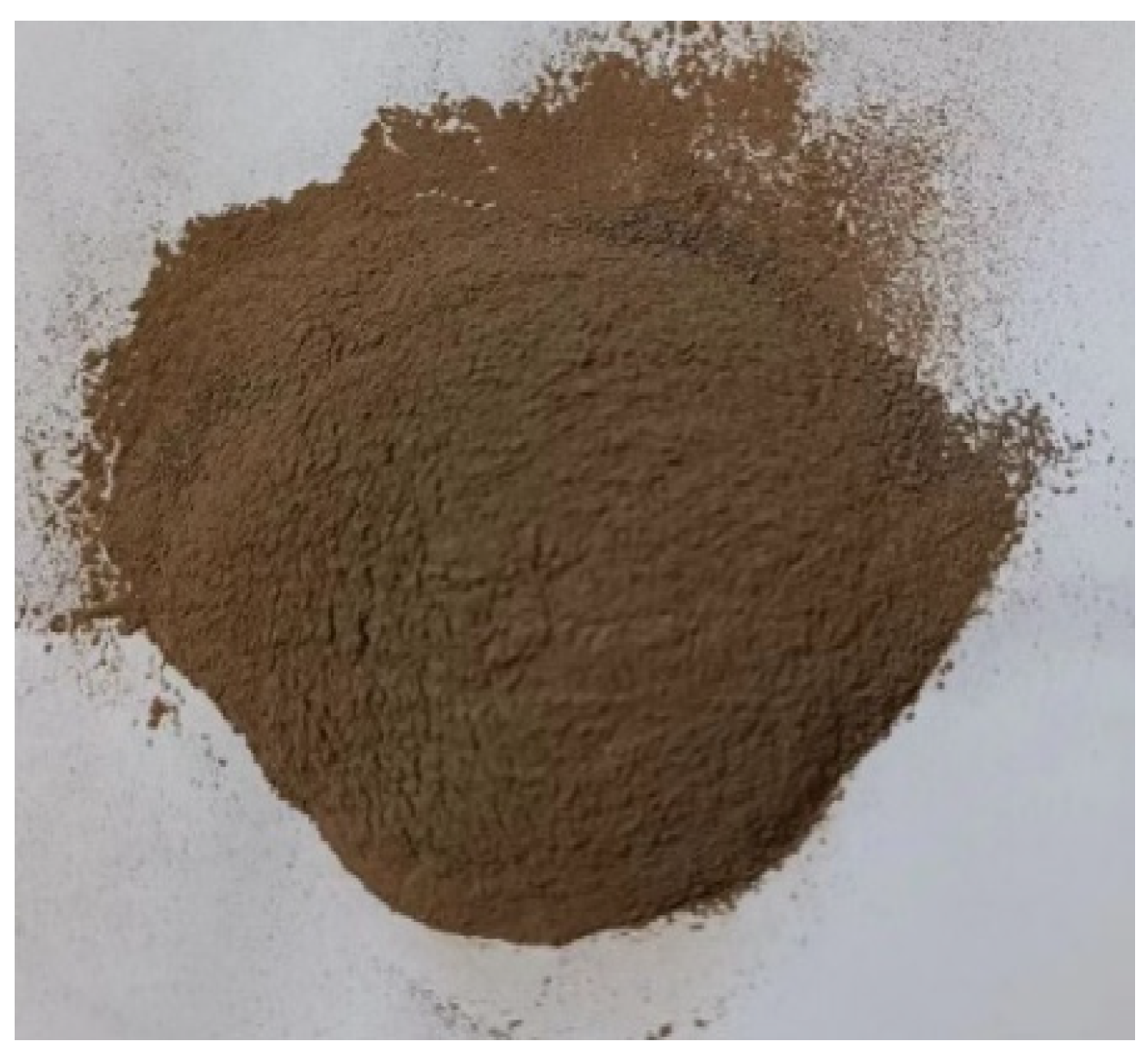
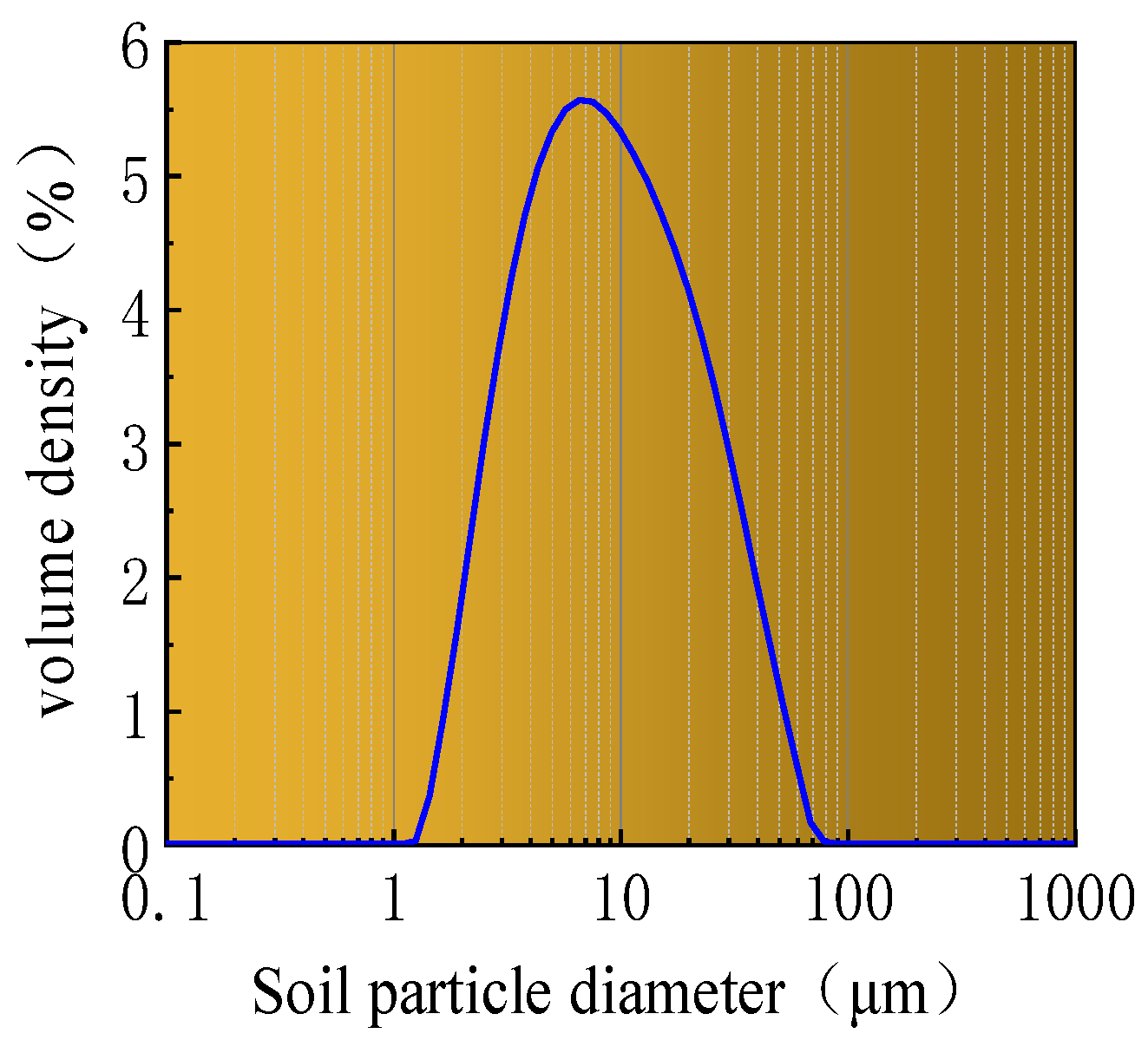
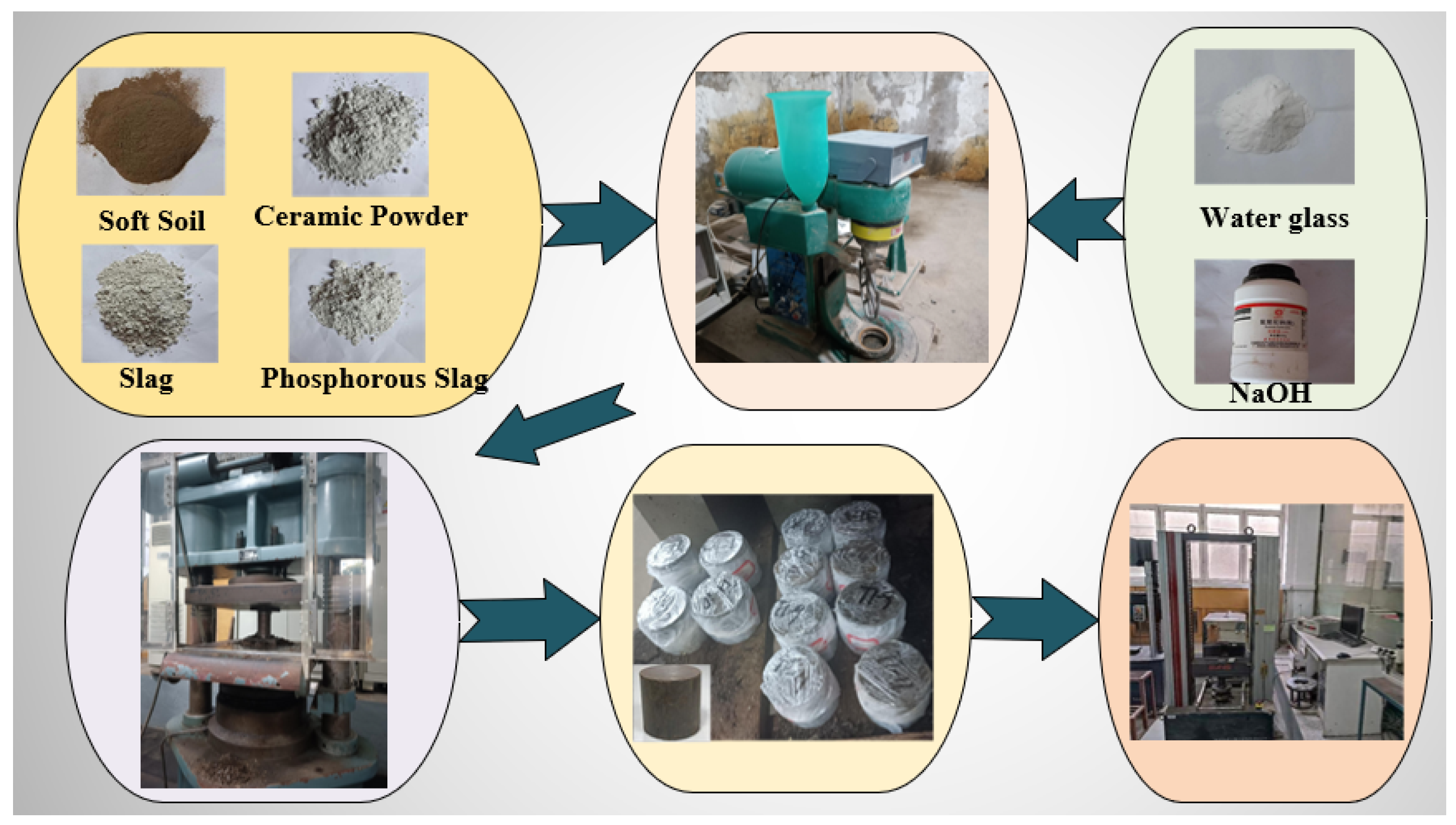

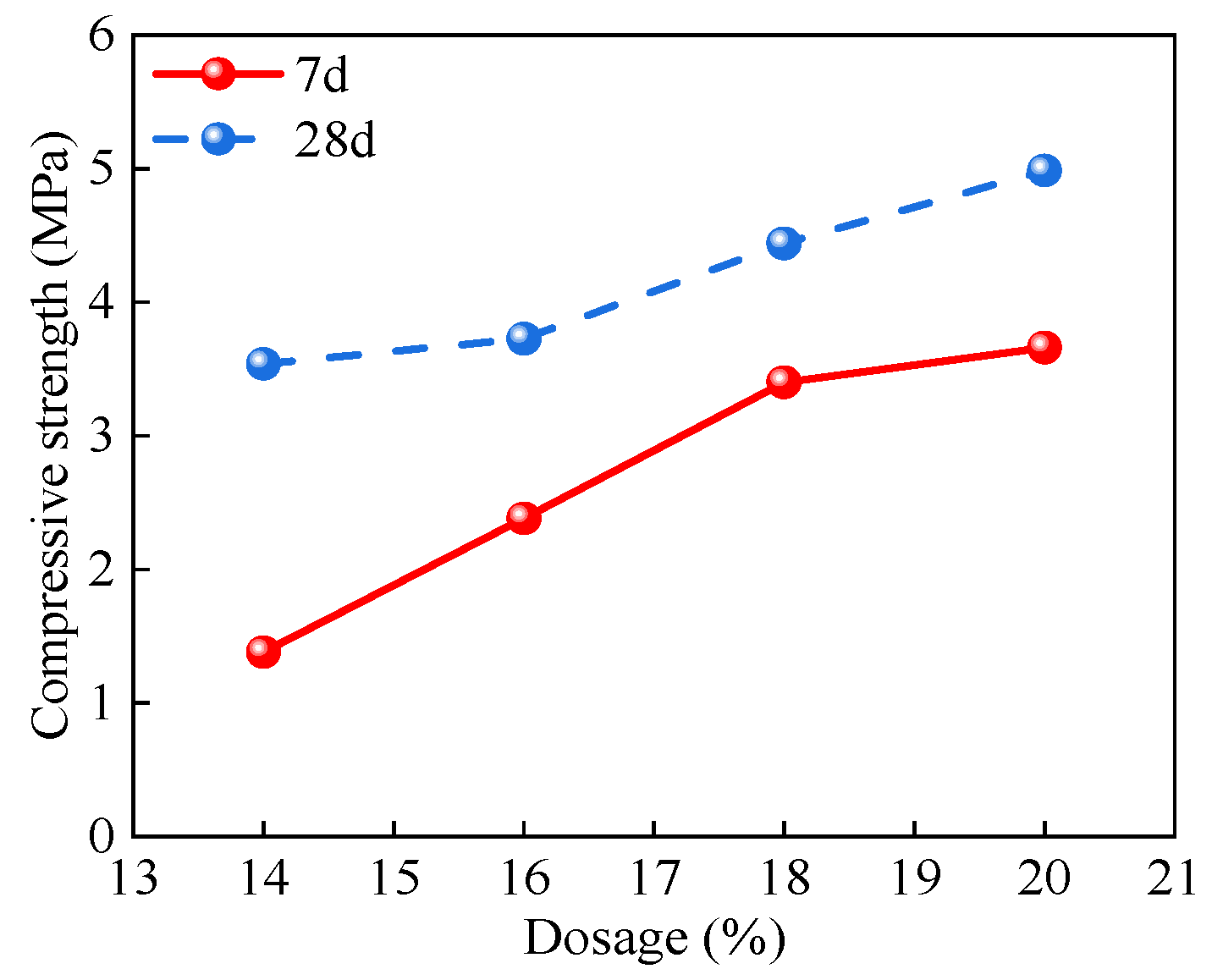




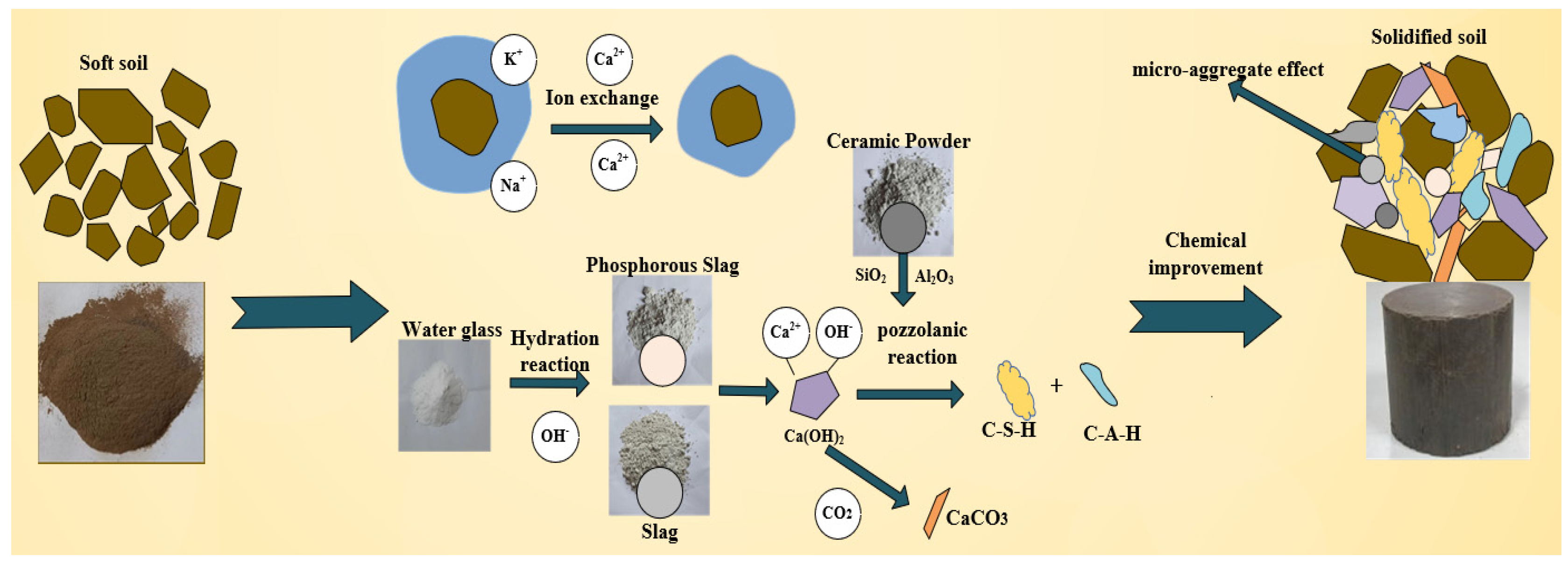
| Chemical Composition | SiO2 | Al2O3 | CaO | MgO | Fe2O3 |
|---|---|---|---|---|---|
| Soft soil | 66.84 | 16.17 | 1.67 | 1.16 | 8.4 |
| Chemical Composition | SiO2 | Al2O3 | CaO | MgO | Fe2O3 | SO3 |
|---|---|---|---|---|---|---|
| Ceramic powder | 66.34 | 24.1 | 2.51 | 0.56 | 1.57 | 0.06 |
| Slag | 25.62 | 12.07 | 50.22 | 5.18 | 0.31 | 2.41 |
| Phosphorus slag | 30.09 | 4.6 | 49.37 | 1.71 | 1.05 | 4.06 |
| Level | Factor | ||
|---|---|---|---|
| Ceramic Powder/Slag/Phosphorus Slag | Module of Water Glass | Water Glass Content | |
| 1 | 4:3:1 | 1.0 | 20% |
| 2 | 3:2:1 | 1.3 | 23% |
| 3 | 2:2:1 | 1.6 | 26% |
| Number | Ceramic Powder/Slag/Phosphorus Slag | Module of Water Glass | Water Glass Content | Unconfined Compression Strength (MPa) |
|---|---|---|---|---|
| T-L-1 | 4:3:1 | 1.0 | 20% | 1.000 |
| T-L-2 | 4:3:1 | 1.3 | 26% | 0.766 |
| T-L-3 | 4:3:1 | 1.6 | 23% | 0.713 |
| T-L-4 | 3:2:1 | 1.0 | 26% | 2.382 |
| T-L-5 | 3:2:1 | 1.3 | 23% | 1.003 |
| T-L-6 | 3:2:1 | 1.6 | 20% | 0.605 |
| T-L-7 | 2:2:1 | 1.0 | 23% | 1.892 |
| T-L-8 | 2:2:1 | 1.3 | 20% | 0.835 |
| T-L-9 | 2:2:1 | 1.6 | 26% | 0.806 |
| Ceramic Powder/Slag/Phosphorus Slag | Module of Water Glass | Water Glass Content | |
|---|---|---|---|
| k1 | 0.826 | 1.758 | 0.813 |
| k2 | 1.330 | 0.868 | 1.203 |
| k3 | 1.178 | 0.708 | 1.318 |
| R | 0.504 | 1.050 | 0.505 |
| Influencing primary and secondary factors | B > C > A | ||
| Number | Water Content | 7-Day (MPa) | 28-Day (MPa) |
|---|---|---|---|
| T1-1 | 30% | 2.832 | 3.727 |
| T1-2 | 35% | 2.267 | 3.161 |
| T1-3 | 40% | 0.928 | 2.174 |
| T1-4 | 45% | 0.340 | 1.246 |
| Number | Dosage | 7-Day (MPa) | 28-Day (MPa) |
|---|---|---|---|
| T1-5 | 14% | 1.380 | 3.539 |
| T1-6 | 16% | 2.382 | 3.727 |
| T1-7 | 18% | 3.400 | 4.439 |
| T1-8 | 20% | 3.660 | 4.985 |
| Number | Ceramic Powder: Slag: Phosphorus Slag | Module of Water Glass | Water Glass Content | Water Content | Admixture | 7-Day/MPa | 28-Day/Mpa |
|---|---|---|---|---|---|---|---|
| T1-9 | 3:2:1 | 1 | 26% | 30% | 1% Triisopropanolamine | 2.262 | 4.163 |
| T1-10 | 3:2:1 | 1 | 26% | 30% | 1.5% Triisopropanolamine | 2.561 | 4.953 |
| T1-11 | 3:2:1 | 1 | 26% | 30% | 2% Triisopropanolamine | 3.137 | 3.844 |
| T1-12 | 3:2:1 | 1 | 26% | 30% | 2.5% Triisopropanolamine | 2.419 | 3.581 |
| T1-13 | 3:2:1 | 1 | 26% | 30% | 1% Anhydrous sodium sulfate | 2.221 | 3.136 |
| T1-14 | 3:2:1 | 1 | 26% | 30% | 1.5% Anhydrous sodium sulfate | 2.556 | 3.601 |
| T1-15 | 3:2:1 | 1 | 26% | 30% | 2% Anhydrous sodium sulfate | 1.935 | 3.442 |
| T1-16 | 3:2:1 | 1 | 26% | 30% | 2.5% Anhydrous sodium sulfate | 1.762 | 3.433 |
| T1-17 | 3:2:1 | 1 | 26% | 30% | 1% Pac | 1.700 | 3.614 |
| T1-18 | 3:2:1 | 1 | 26% | 30% | 1.5% Pac | 2.591 | 3.655 |
| T1-19 | 3:2:1 | 1 | 26% | 30% | 2% Pac | 1.731 | 3.775 |
| T1-20 | 3:2:1 | 1 | 26% | 30% | 2.5% Pac | 1.598 | 3.227 |
| Element | Mass Percentage (%) | Atomic Percentage (%) | ||||||
|---|---|---|---|---|---|---|---|---|
| S1 | S2 | S3 | S4 | S1 | S2 | S3 | S4 | |
| C | 6.23 | 5.08 | 3.13 | 3.07 | 11.25 | 9.25 | 6.45 | 6.21 |
| O | 36.07 | 37.07 | 25.02 | 26.84 | 48.91 | 50.62 | 38.62 | 40.71 |
| Na | 2.44 | 2.08 | 1.57 | 1.55 | 2.31 | 1.98 | 1.68 | 1.64 |
| Mg | 0.92 | 0.91 | 0.99 | 0.92 | 0.82 | 0.82 | 1.00 | 0.92 |
| Al | 11.66 | 11.70 | 14.26 | 13.90 | 9.38 | 9.48 | 13.05 | 12.50 |
| Si | 24.25 | 24.59 | 28.85 | 29.11 | 18.73 | 19.13 | 25.37 | 25.15 |
| K | 3.54 | 3.67 | 6.34 | 6.01 | 1.96 | 2.05 | 4.00 | 3.73 |
| Ca | 5.45 | 5.40 | 5.75 | 6.02 | 2.95 | 2.94 | 3.54 | 3.64 |
| Ti | 0.37 | 0.32 | 0.53 | 0.43 | 0.17 | 0.15 | 0.27 | 0.22 |
| Fe | 9.08 | 9.18 | 13.58 | 12.15 | 3.53 | 3.59 | 6.00 | 5.28 |
Disclaimer/Publisher’s Note: The statements, opinions and data contained in all publications are solely those of the individual author(s) and contributor(s) and not of MDPI and/or the editor(s). MDPI and/or the editor(s) disclaim responsibility for any injury to people or property resulting from any ideas, methods, instructions or products referred to in the content. |
© 2023 by the authors. Licensee MDPI, Basel, Switzerland. This article is an open access article distributed under the terms and conditions of the Creative Commons Attribution (CC BY) license (https://creativecommons.org/licenses/by/4.0/).
Share and Cite
Shang, Y.; Cui, Z.; Zhang, Y. Experimental Study on the Synergistic Solidification of Soft Soil with Ceramic Powder–Slag–Phosphorus Slag. Sustainability 2023, 15, 15474. https://doi.org/10.3390/su152115474
Shang Y, Cui Z, Zhang Y. Experimental Study on the Synergistic Solidification of Soft Soil with Ceramic Powder–Slag–Phosphorus Slag. Sustainability. 2023; 15(21):15474. https://doi.org/10.3390/su152115474
Chicago/Turabian StyleShang, Yunzhi, Zhenglong Cui, and Yannian Zhang. 2023. "Experimental Study on the Synergistic Solidification of Soft Soil with Ceramic Powder–Slag–Phosphorus Slag" Sustainability 15, no. 21: 15474. https://doi.org/10.3390/su152115474






